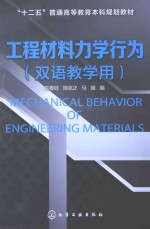图书介绍
工程材料力学行为 双语教学用书 汉英对照PDF|Epub|txt|kindle电子书版本网盘下载

- 刘春廷,陈克正,马继编 著
- 出版社: 北京:化学工业出版社
- ISBN:9787122223494
- 出版时间:2015
- 标注页数:255页
- 文件大小:50MB
- 文件页数:265页
- 主题词:工程材料-材料力学性质-高等学校-教材-汉、英
PDF下载
下载说明
工程材料力学行为 双语教学用书 汉英对照PDF格式电子书版下载
下载的文件为RAR压缩包。需要使用解压软件进行解压得到PDF格式图书。建议使用BT下载工具Free Download Manager进行下载,简称FDM(免费,没有广告,支持多平台)。本站资源全部打包为BT种子。所以需要使用专业的BT下载软件进行下载。如BitComet qBittorrent uTorrent等BT下载工具。迅雷目前由于本站不是热门资源。不推荐使用!后期资源热门了。安装了迅雷也可以迅雷进行下载!
(文件页数 要大于 标注页数,上中下等多册电子书除外)
注意:本站所有压缩包均有解压码: 点击下载压缩包解压工具
图书目录
Chapter 1 Introduction1
REFERENCES6
Chapter 2 Mechanical Properties of Metals7
2.1 Introduction7
2.2 Concepts of Stress and Strain8
2.3 Stress-Strain Behavior11
2.4 Anelasticity(or Viscoelasticity)18
2.5 Elastic Properties of Materials18
2.6 Tensile Properties20
2.6.1 Yield Strength20
2.6.2 Tensile Strength21
2.6.3 Ductility24
2.6.4 Toughness25
2.6.5 Resilience26
2.7 True Stress and Strain26
2.8 Elastic Recovery After Plastic Deformation31
2.9 Compressive,Shear,and Torsion Deformation31
2.10 Hardness32
2.10.1 Rockwell Hardness Tests32
2.10.2 Brinell Hardness Tests33
2.10.3 Knoop and Vickers Microindentation Hardness Tests35
2.10.4 Correlation between Hardness and Tensile Strength36
SUMMARY37
IMPORTANT TERMS AND CONCEPTS38
REFERENCES38
QUESTIONS AND PROBLEM39
Chapter 3 Fracture:Microscopic Aspects45
3.1 Introduction45
3.2 Classification of Fracture45
3.2.1 Ductile Fracture46
3.2.2 Brittle Fracture46
3.3 Process of Fracture47
3.3.1 Crack Nucleation47
3.3.2 Ductile Fracture51
3.3.3 Brittle,Cleavage Fracture55
3.4 Impact Fracture60
3.4.1 Impact Testing Techniques60
3.4.2 Ductile-to-Brittle Transition62
SUMMARY65
IMPORTANT TERMS AND CONCEPTS65
REFERENCES66
QUESTIONS AND PROBLEMS66
Chapter 4 Fracture:Macroscopic Aspects68
4.1 Introduction68
4.2 Theoretical Cleavage Strength69
4.3 Stress Concentration71
4.3.1 Stress Concentrations71
4.3.2 Stress Concentration Factor72
4.4 Griffith Criterion of Fracture75
4.5 Fracture Toughness80
4.5.1 Hypotheses of LEFM81
4.5.2 Crack Tip Separation Modes81
4.5.3 Stress Field in an Isotropic Material in the Vicinity of a Crack Tip83
4.5.4 Details of the Crack-Tip Stress Field in Mode Ⅰ84
4.5.5 Plastic-Zone Size Correction87
4.6 Fracture Toughness Parameters89
4.6.1 Crack Extension Force G89
4.6.2 Crack Tip Opening Displacement(CTOD)91
4.6.3 J Integral93
4.6.4 R Curve95
4.6.5 Relationships among Different Fracture Toughness Parameters96
SUMMARY97
IMPORTANT TERMS AND CONCEPTS98
REFERENCES98
QUESTIONS AND PROBLEMS99
Chapter 5 Fatigue of Metal Materials102
5.1 Introduction102
5.2 Cyclic Stresses102
5.3 The S-N Curve104
5.4 Mechanisms of Fatigue107
5.4.1 Fatigue Crack Nucleation108
5.4.2 Fatigue Crack Propagation110
5.5 Linear Elastic Fracture Mechanics Applied to Fatigue114
5.6 Factors That Affect Fatigue Life118
5.7 Environmental Effects121
SUMMARY122
IMPORTANT TERMS AND CONCEPTS122
REFERENCES123
QUESTIONS AND PROBLEMS123
Chapter 6 Creep of Metal Materials126
6.1 Introduction126
6.2 Generalized Creep Behavior127
6.3 Stress and Temperature Effects129
6.4 Fundamental Mechanisms Responsible for Creep132
6.4.1 Diffusion Creep133
6.4.2 Dislocation(or Power Law)Creep135
6.4.3 Dislocation Glide137
6.4.4 Grain-Boundary Sliding137
6.5 Data Extrapolation Methods139
6.6 Alloys for High-Temperature142
SUMMARY146
IMPORTANT TERMS AND CONCEPTS147
REFERENCES147
QUESTIONS AND PROBLEMS148
Chapter 7 Strengthening Strategies of Metal Materials150
7.1 Introduction150
7.2 Dislocations151
7.3 Boundary Strengthening153
7.4 Strain Hardening(or Cold Working)156
7.5 Solid-Solution Alloying159
7.6 Precipitation-and Dispersion-Alloying162
SUMMARY168
IMPORTANT TERMS AND CONCEPTS169
REFERENCES169
QUESTIONS AND PROBLEMS169
Chapter 8 Meehanical Behavior of Ceramics Materials171
8.1 Introduction171
8.2 Stress-Strain Behavior171
8.3 Mechanisms of Plastic Deformation174
8.4 Brittle Fracture of Ceramics175
8.5 Various Mechanical Considerations180
SUMMARY182
IMPORTANT TERMS AND CONCEPTS182
REFERENCES182
QUESTIONS AND PROBLEMS183
Chapter 9 Mechanical properties of Polymers Materials185
9.1 Introduction185
9.2 Stress-Strain Behavior185
9.3 Macroscopic Deformation188
9.4 Viscoelastic Deformation189
9.5 Dcformation of Elastomers195
9.6 Fracture of Polymers198
9.7 Various Mechanical Characteristics200
9.8 Mechanisms of Deformation and for Strengthening of Polymers202
9.9 Factors that Influence the Mechanical Properties of Semicrystalline204
SUMMARY206
IMPORTANT TERMS AND CONCEPTS208
REFERENCES208
QUESTIONS AND PROBLEMS208
Chapter 10 Mechanical Properties of Composite Materials210
10.1 Introduction210
10.2 Stress-Strain Behavior212
10.2.1 Elastic Moduli214
10.2.2 Strength216
10.3 Toughness218
10.4 Fracture in Composites221
10.4.1 Single and Multiple Fracture221
10.4.2 Failure Modes in Composites222
SUMMARY226
IMPORTANT TERMS AND CONCEPTS226
REFERENCES226
QUESTIONS AND PROBLEMS227
Chapter 11 Envi ronmental Effects in Metals,Ceramics and Polymers229
11.1 Introduction229
11.2 Electrochemical Nature of Corrosion in Metals230
11.3 Passivity233
11 4 Forms of Corrosion235
11.5 Environmentally Assisted Fracture in Metals238
11.5.1 Stress Corrosion Cracking(SCC)239
11.5.2 Hydrogen Damage in Metals242
11.6 Corrosion of Ceramic Materials248
11.7 Degradation of Polymers249
11.7.1 Swelling and Dissolution249
11.7.2 Bond Rupture249
11.7.3 Weathering250
11.8 Corrosion Prevention251
SUMMARY251
IMPORTANT TERMS AND CONCEPTS253
REFERENCES253
QUESTIONS AND PROBLEMS254